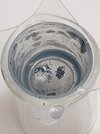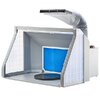Air brush problem
- Thread starter Trev
- Start date
Pantherman
Well-Known Member
- Joined
- Feb 10, 2022
- Messages
- 4,163
Dry air possibly but humid air should not dry up the tip.Hi guys further to my question. Have to do my airbrush work outside as the wife complains!!. So would the temperature affect the dry tip?
Vallejo paints are very low odour, my wife also moans about the smell. Apparently hairspray, nail varnish and all the other stuff they use doesn't smell at all........ Pantherman
Jakko
Well-Known Member
- Joined
- Oct 9, 2024
- Messages
- 1,226
You don't really smell things you're very used to. After 35 years of using Tamiya paints, I can happily sit with a pot of it open for any length of time I like, I just don't smell it anymore unless I actually sniff the bottle. But pretty much every time I've ever opened a bottle near someone who's not a modeller, they mentioned the smell within seconds.Apparently hairspray, nail varnish and all the other stuff they use doesn't smell at all........
Pantherman
Well-Known Member
- Joined
- Feb 10, 2022
- Messages
- 4,163
Good point. PanthermanYou don't really smell things you're very used to. After 35 years of using Tamiya paints, I can happily sit with a pot of it open for any length of time I like, I just don't smell it anymore unless I actually sniff the bottle. But pretty much every time I've ever opened a bottle near someone who's not a modeller, they mentioned the smell within seconds.
- Joined
- Sep 4, 2022
- Messages
- 2,622
That explains a lot, Jakko!I can happily sit with a pot of it open for any length of time I like,
Edbert
Well-Known Member
- Joined
- May 16, 2024
- Messages
- 1,733
As someone diagnosed (no pun intended and unofficially/clinically) as suffering from nose blindness...this might be true.You don't really smell things you're very used to. After 35 years of using Tamiya paints, I can happily sit with a pot of it open for any length of time I like, I just don't smell it anymore unless I actually sniff the bottle. But pretty much every time I've ever opened a bottle near someone who's not a modeller, they mentioned the smell within seconds.
I have been using an airbrush for 15 years now and overall really like it. That said keeping it in working order is troublesome. I use almost only acrylics with it and they will clog it up and fairly rapidly. So after a number of sessions it's time to tear them down. I have a Tamiya HS and a standard and very fine Badger and like them all. Overall I like the standard Badger best as it seems to stay cleaner through multiple uses than the Tamiya. But after multiple uses, cleaning rapidly between uses by running water and scrubbing the cup, they all require teardown. I didn't learn that until I had used them for a while at the beginning. I completely take them apart and soak the nozzles in brush cleaner. Than I clean out the cups with brush cleaner and a pipe cleaner or manicure brushes. Intermittently I also disassemble the valve and have replaced o-rings a couple of times. Once the nozzle is soaked I 'ream" it with spare needle and small manicure brush to get the inside clean, carefully of course. Reassembly and flow some water through to make sure it's OK. On rare occasions something has gummed up doing that and I have to check it out. I don't think the problems are quite as bad if you spray lacquers and use lacquer cleaner to clean it. Acrylics seem to gum it up quicker but I like acrylics. They are great for general use and special effects but will require effort to keep clean.
Last edited:
RocketRanger
Member
- Joined
- Jul 17, 2024
- Messages
- 30
One thing I found that clogged my airbrush while airbrushing acrylics (e.g Vallejo Model Air) is little solid/semi-solid chunks or blobs in the paint that block the spray tip. Another model club member mentioned this and I didn't believe this could be a cause of blocking. He recommended using a filter screen in the paint cup to catch these little paint chunks. So I bought one and placed it in the airbrush paint cup where the paint flowed through like a coffee filter. When I looked inside the filter after airbrushing, there were indeed small paint chunks that were the proper size to clog up the paint tip. I've been using a paint filter cup for acrylics ever since and my tip clogging problems have been drastically reduced. There are a couple types of these paint filters available and can be found by Googling the phrase: airbrush paint filter cup. And be sure to measure the diameter of your airbrush paint cup to order the correct size.
Generally, these cups are reusable and just need to be run under a water faucet and scrubbed with a toothbrush to clean the paint from the cup and filter then wiped with something soaked in thinner to clean the inside of the cup. I've had mine for almost 10 years now and it still works fine. BTW: This globbing problem is mostly an issue with acrylics and less so with enamels and lacquers.
And here is a photo of the paint globs that got filtered out to show what can clog the spray tip.

Generally, these cups are reusable and just need to be run under a water faucet and scrubbed with a toothbrush to clean the paint from the cup and filter then wiped with something soaked in thinner to clean the inside of the cup. I've had mine for almost 10 years now and it still works fine. BTW: This globbing problem is mostly an issue with acrylics and less so with enamels and lacquers.
And here is a photo of the paint globs that got filtered out to show what can clog the spray tip.

Last edited:
Edbert
Well-Known Member
- Joined
- May 16, 2024
- Messages
- 1,733
Dang, that is terrible! That could completely clog up an airbrush, a tiny blob (compared to those) could make it spray erratically.And here is a photo of the paint globs that got filtered out to show what can clog the spray tip.
Are you putting unused paint from the airbrush back into the jars? I've heard of people having deposits from reusing pipettes too.
RocketRanger
Member
- Joined
- Jul 17, 2024
- Messages
- 30
No, I never reuse any paint after airbrushing. I always dispose of it by pouring what's left in the airbrush cup directly into a waste container. The example paint blobs shown in the photo were from a brand new Vallejo Model Air bottle. I suspect the blobs formed when the paint was in contact with the air inside the bottle during shipping and while sitting on the shelves at the store and in my workshop before use.Dang, that is terrible! That could completely clog up an airbrush, a tiny blob (compared to those) could make it spray erratically.
Are you putting unused paint from the airbrush back into the jars? I've heard of people having deposits from reusing pipettes too.
- Joined
- Dec 1, 2024
- Messages
- 408
I used to use your method for all other paints except Vallejo Model Air (VMA). I've been using it for years, some of my bottles are almost 10 years old, and I've never had a single clog, or anything like what you are showing us. I'm also puzzled by the size of those particles, because VMA comes in dropper bottles that would themselves clog from particles that big.paint blobs shown in the photo were from a brand new Vallejo Model Air bottle. I suspect the blobs formed when the paint was in contact with the air inside the bottle during shipping and while sitting on the shelves at the store and in my workshop before use.
One thing I know is that some acrylic paints, especially thin ones like VMA, settle hard, and can be difficult to redisperse. The paint volume in the bottle is small, and hand shaking may not do the job. I put one or two stainless steel balls in the VMA bottle. I bought a small paint shaker to save my arthritic joints, and use that for mixing.

